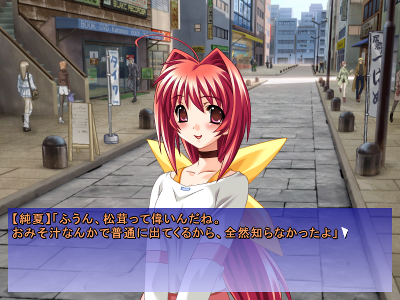
Like all visual novels these games are nearly all dialog between the protagonist and other characters in the story, which are depicted as flat images against a background.
#MUV LUV GAME SEX SERIES#
The visual novel series consists of three games ( Muv-Luv Extra, Unlimited, and Alternative), which must be played in progression to be understood. I can’t help but wonder if the same is true for the Muv-Luv series. It’s clear that Suzuki and Kurosawa used their pulp genres as a cover for their more complex ideas. Perhaps the constraints themselves helped them produce films that are startling and creative. They met the guidelines of their genres but found ways to subvert the content of their work. Yet both directors tried to do something interesting within their form. Suzuki and Kurosawa were working on pulp films that came with a lot of restrictions, both in terms of genre expectations and production logistics. Twelve years later, Kurosawa appeared seemingly out of nowhere with Cure (1997), the first in a series of weird and very scary films that established him as one of Japan’s most interesting contemporary directors. Nikkatsu fired Kurosawa, who eventually bought the film back and released it himself. Like Kurosawa’s later films, The Excitement of Do-Re-Mi-Fa Girl has a dream-like quality to it, and it’s never clear if the events on the screen are to be taken literally or as a metaphor for something else.
#MUV LUV GAME SEX MOVIE#
Nikkatsu probably expected Do-Re-Mi-Fa Girl to be a sexy movie about a naive girl who learns about sex from free-spirited college students, but what they got instead was a weird art film about shame and personal boundaries. Junior filmmaker Kiyoshi Kurosawa produced two movies for Nikkatsu in the early 1980s, including The Excitement of Do-Re-Mi-Fa Girl (1985), which he wrote, directed, and edited. This effort saved the company, and by the 1980s they were willing to fund just about any film as long as it met its nudity quota. In the 1970s Nikkatsu burned through the yakuza film crop and switched to pinku eiga soft porn.

Although Nikkatsu produced a huge volume of films during the 1950s and 1960s, today Suzuki’s are the only ones that anybody remembers. In Branded to Kill (1967, his last film for Nikkatsu), the contract killer protagonist becomes roommates with his target, who is also trying to kill him. At one point in Tokyo Drifter (1966), the entire set inexplicably turns white. Steadily his movies got stranger and stranger. He made 40 films in 12 years for Nikkatsu, each allocated less than 40 days of production from start to finish. In 1967 yakuza filmmaker Seijun Suzuki was fired from his job at Nikkatsu Company for being too weird. Yoriko Douguchi is not interested in your crap.


 0 kommentar(er)
0 kommentar(er)
